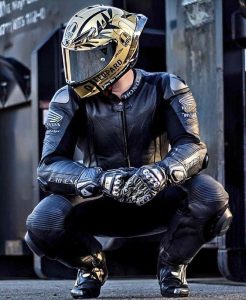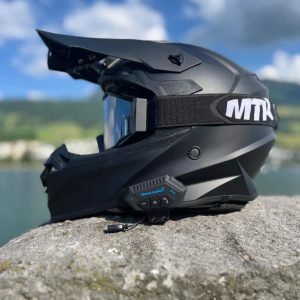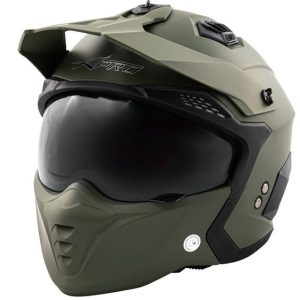Jun 14, 2024
What Style Motorcycle Helmet is the Safest?
When it comes to motorcycle safety, a helmet is the single most important piece of gear you can wear. It protects your head in the event of a crash, which can significantly reduce your risk of serious injury or death. What style motorcycle helmet is the safest? But with so many different styles of motorcycle helmets on the market, it can be tough to know which one is right for you.
This article will explore the different types of motorcycle helmets available, their pros and cons, and the factors to consider when choosing a helmet.
Types of Motorcycle Helmets
There are three main types of motorcycle helmets:
Full-face helmets:
Full-face helmets offer the most protection, covering your entire head, face, and chin. They are the safest option for motorcycle riders.
Modular helmets:
Modular helmets, also known as flip-up helmets, have a chin bar that can be flipped up and out of the way. This can be convenient for eating, drinking, or talking on the phone while stopped. However, modular helmets do not offer the same level of protection as full-face helmets.
Open-face helmets:
Open-face helmets, also known as half helmets, only protect the top and back of your head. They offer the least protection of all the helmet styles.

Pros and Cons of Different Helmet Styles
Here is a closer look at the pros and cons of each type of motorcycle helmet:
Full-face helmets
- Pros: Offer the most protection, protect your face and chin, good wind protection, many features available (e.g., sun visor, fog shield)
- Cons: Can be heavy and hot, limited visibility compared to some other styles
Modular helmets
- Pros: More versatile than full-face helmets, can be flipped up for convenience, offer good protection
- Cons: Not as protective as full-face helmets, chin bar can snag in a crash
Open-face helmets
- Pros: Light and cool, provide good visibility
- Cons: Offer the least protection, leave your face and chin exposed
Factors to Consider When Choosing a Helmet
Here are some key factors to consider when choosing a motorcycle helmet:
- Safety: The most important factor is safety. Choose a helmet that is DOT-certified, which means it meets the minimum safety standards set by the U.S. Department of Transportation.
- Fit: A helmet should fit snugly but comfortably. It should not move around on your head when you shake it.
- Weight: A lighter helmet will be more comfortable to wear, especially on long rides.
- Ventilation: A well-ventilated helmet will help you stay cool and comfortable in hot weather.
- Visibility: Choose a helmet with a clear visor that provides good visibility.
- Features: Some helmets come with features such as a sun visor, fog shield, or internal communication system. Decide which features are important to you.
Choosing the Right Helmet for You
The best motorcycle helmet for you will depend on your individual needs and preferences. Consider the type of riding you do, the climate you live in, and your personal safety priorities.
Here are some general recommendations:
- If safety is your top priority, choose a full-face helmet.
- If you want a helmet that is more versatile, consider a modular helmet.
- If you prefer a lighter and cooler helmet, an open-face helmet may be an option, but be aware of the safety risks.
Safety Features to Prioritize
- DOT Certification: Regardless of style, your helmet should always be DOT-certified. This ensures it meets the minimum safety standards set by the U.S. Department of Transportation. Look for the DOT sticker on the inside of the helmet.
- Proper Fit: A snug but comfortable fit is essential. The helmet should not move around when you shake your head. A loose helmet may come off in a crash, while a too-tight helmet can be uncomfortable and lead to headaches.
Finding Your Perfect Match
Once you have safety covered, consider your riding style and preferences to find a helmet that balances comfort and features.
- Comfort Features: Look for helmets with good ventilation to keep you cool on hot rides. A lighter helmet will also be more comfortable, especially for long journeys.
- Visibility: A clear, undamaged visor is crucial for optimal vision. Choose a helmet with a visor that offers a wide field of view. Anti-scratch coatings can also be helpful.
- Extra Features: Some helmets include sun visors, fog shields, or internal communication systems. Decide which features are important to you and choose a helmet accordingly.
There is no single “best” motorcycle helmet style. The ideal helmet offers a balance between safety, comfort, and features that suit your riding needs. By prioritizing safety with DOT certification and proper fit, you can find a helmet that you’ll enjoy wearing on every ride.
Additional Considerations for Your Ride
Once you’ve prioritized safety with DOT certification and proper fit, consider your riding style and preferences to find a helmet that you’ll enjoy wearing.
- Comfort Matters: Look for helmets with good ventilation to keep you cool on hot rides. A lighter helmet will also be more comfortable, especially for long journeys.
- See Clearly, Ride Safely: A clear, undamaged visor is crucial for optimal vision. Choose a helmet with a visor that offers a wide field of view. Anti-scratch coatings can also be helpful.
The ideal motorcycle helmet offers a perfect blend of safety and comfort. By prioritizing DOT certification and proper fit, you can find a helmet that you’ll enjoy wearing on every ride. Remember, a helmet is your essential gear for motorcycle safety.

When selecting a motorcycle helmet, consider opting for a style that not only complements your personal taste but also prioritizes safety. Full-face helmets offer the most comprehensive protection, covering the entire head and face, including the chin. They provide excellent protection from impacts, wind, and debris. Modular helmets combine the benefits of full-face and open-face designs, featuring a flip-up chin bar for added versatility. Open-face helmets offer a classic, minimalist look and provide ample ventilation and visibility, although they offer less protection than full-face options. Half helmets provide the least coverage, protecting only the top of the head and leaving the face exposed. While they offer a more open riding experience, they may not provide adequate protection in the event of a crash. Ultimately, choose a helmet style that fits securely, meets safety standards, and aligns with your riding preferences.


